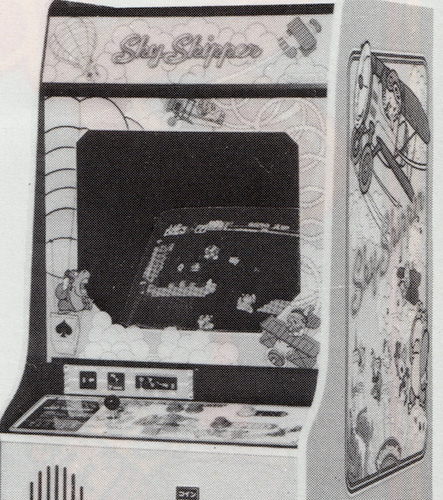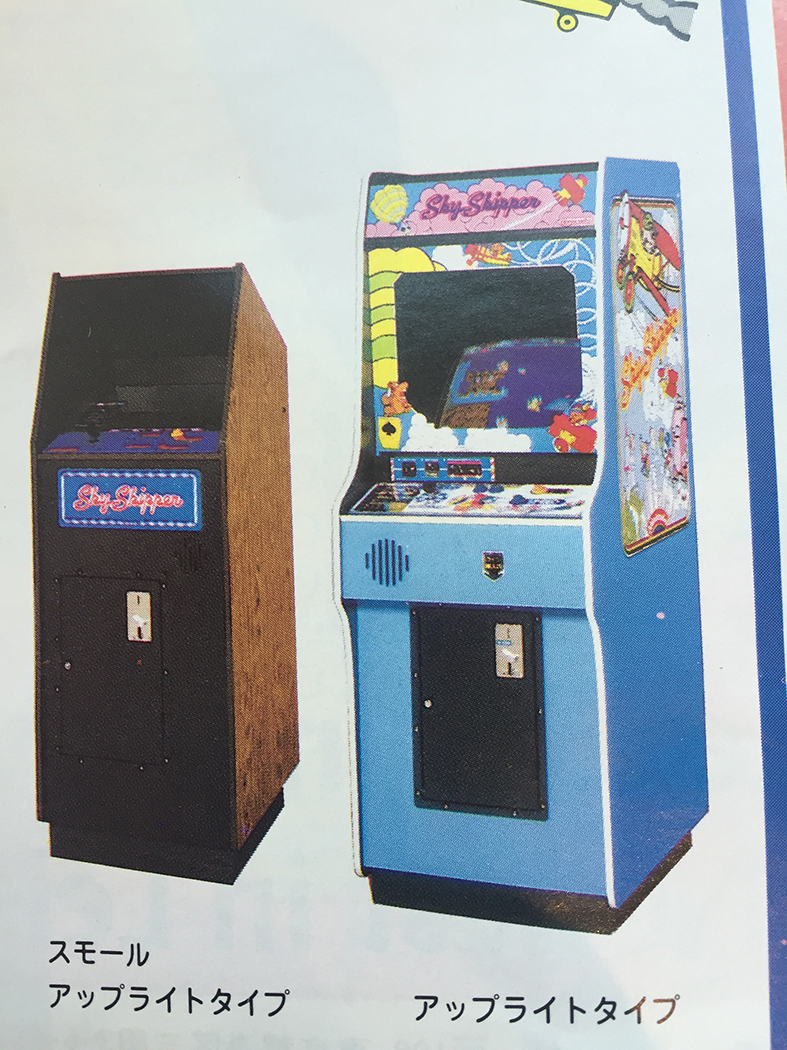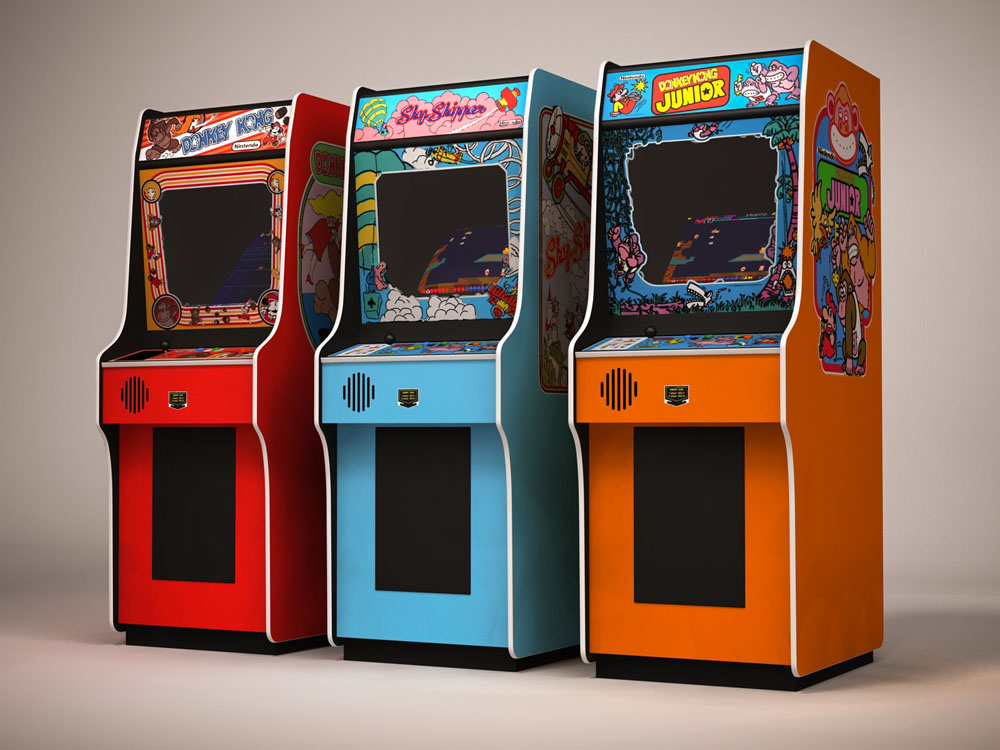A lot of extraordinary things go on in this hobby. One of the highlights for me is observing the dedication of some collectors. Some of these guys are really, really passionate, and are prepared to go above and beyond to preserve classic arcade games. I guess this is partly driven by a desire to take on a real challenge, doing research and investigation; but also by a genuine passion for the preservation and recording of much of the history surrounding these early pioneering arcade games – many of which have been destroyed or forgotten. So for this week’s post, I thought you’d like to hear a short tale about one such endeavour.

For those that don’t know, Nintendo has a sound track record in arcade games which goes back some 40 years or so, starting with the release of the 1975 title EVR Race. Mario himself had his first outing in the arcades via seminal title Donkey Kong in 1981. The iconic Nintendo cabinet shape of the early 80s housed many truly classic games: The Donkey Kong series, Radar Scope, Helifire, Popeye and of course Mario Bros to name a few.
But surprisingly, there are a handful of Nintendo arcade titles that never made it over to the West, and just one or two that never received a major release in their home territory of Japan.

One of these games is Nintendo’s Sky Skipper. Released in 1981 following the smash hit Donkey Kong, the game sees the player controlling a bi-plane as “Mr You”, on a mission to rescue various members of a royal family scattered around four levels, whilst avoiding gorillas (sound familiar?) along the way. The bi-plane has limited fuel, so tactics need to be at the forefront of the player’s mind. Think Robotron meets Time Pilot and you’re in the ballpark.

Interestingly, some game play elements of the game were used in 1982’s Popeye, which of course saw a Western release and is now revered as a classic early platformer.
Sky Skipper itself was not a huge draw in Japan. Nintendo quickly discovered that the game was not being played as much as they would like for it to be a viable release. This lukewarm reception from Japanese players meant that the game was not considered for a release here in the West. It is believed that Nintendo wisely decided to convert and re-purpose its remaining Sky Skipper hardware inventory into Popeye PCBs. So as well as dedicated Popeye boards, there are a handful of ex-Sky Skipper PCBs that run the Popeye code.
Of course, what this meant was that Sky Skipper as a game, quietly disappeared and was forgotten about. Lost to history, the arcade game became the stuff of legend and nothing more than vague mentions can be found on Nintendo based forum sites over the years.
And here is where it gets interesting. A Swedish collector a few years back shared pictures of his Popeye board, which had clearly been something else in a previous life. After some investigation, he worked out that based on its markings, the Popeye PCB he owned, used to be one of the fabled Sky Skipper boards. Unsuccessful efforts were then made to convert it back to its former self. But de-constructing the make up of this arcade board turned out to be impossible. Clearly, more than a straight forward ROM swap was required, and without a set of Sky Skipper schematics, or another similar board, this wasn’t going to happen any time soon.

But here’s the thing – if you fire up MAME and search for the game it is there and it is playable. So someone has dumped the ROM code and submitted it to MAME at some point – so whilst it’s possible to play the game in a virtual emulated environment, it would be reasonable to assume that somewhere out there is a working PCB. Where else could the code come from?
Step up Nintendo collector Alex Crowley from the UK. Alex is a passionate advocate for all things Nintendo arcade, and has owned pretty much every arcade release by the Japanese firm from the early eighties in some guise or another. He picks up the story for us:
I’ve been collecting Nintendo arcade games, toys and anything else they’ve made over the last 25 years, But for the last 6 years I’ve concentrated on their early arcade games. I’ve owned all the big releases but there has always been one game that has never conjured up so much mystery as Sky skipper. The reason being there is no information on this game whatsoever. There are no known examples of either a cabinet or the PCB out there anywhere, period.
So they did exist at some point but for some reason none survived. This game was only ever released in Japan; but then why is there a picture of one in a U.S upright cabinet on the back of my flyer? It must have made it to the U.S at some point. I’ve contacted all the big time collectors who have been collecting way longer than I have, and they all said they’ve never seen a cab or a PCB.
Here’s the back of the flyer that Alex refers to:

There it is on the right – alongside cocktail and cabaret versions, housed inside a classic shaped Nintendo cabinet, with full Sky Skipper artwork, bezel, marquee and control panel. It’s worth noting also that those are photographs, not artist mock-ups. Which meant the cab was built and was out there somewhere, at the very least some 35 years ago.
So the hunt was on to solve this mystery. Alex researched hard, contacting all his collector contacts across the globe. The news wasn’t good – no one had any leads on a cabinet or even an original PCB – not even in the USA where Nintendo saw its biggest successes in the arcades of the early 80’s. The assumption was that this game was truly lost. He was given the option to buy the PCB from the Swedish collector, but knowing the impossibility of the task of converting a single board, he decided to pass.
Sensing a wild goose chase, Alex moved on to other things and the hunt for Sky Skipper would have to wait for another day.
Fast forward a few months later, and Alex was fortunate to find himself on a raid at an ex-operator’s warehouse. There were a few cabs to be rescued, along with a bunch of PCBs up on a shelf. Alex got up there on a ladder, and started handing down the boards one by one. A lot of rare stuff was being pulled out – Discs of Tron, Kangaroo and Carnival to name a few. After a few minutes, he swapped places with his mate Oliver, and he was on the receiving end of the remaining PCBs at the bottom of the ladder.
It’s funny. On the journey up to the location in the van, I casually said to Oliver, “I bet there won’t be any Nintendo stuff up there, let alone a Sky Skipper”. Time and again on these raids, we never find anything Nintendo – it was becoming a standing joke.
So we get there and start looking through the stash of arcade stuff, including these PCBs. So he’s handing me down the remainder of the boards from this shelf, and sure enough, one is clearly a Nintendo board marked ‘Popeye’, which I thought was neat – finally, we are finding Nintendo arcade goodies on a raid! But then I looked at it more closely, and the markings clearly had the serial code for Sky Skipper – TNX-01. I knew right away that’s what it was, because I’d studied the pictures of the Swedish board for so long.
I couldn’t believe it. The colour left my body. We’d found an original Sky Skipper that had been converted to Popeye – brand new, still in its protective wrapping. This board had literally come to me, after I’d been looking for one for so long. Apart from the Swedish board, no one had ever seen one of these before. What were the chances of that?

So maybe Nintendo shipped the revised Sky Skipper boards to the European markets? this might explain why the USA collectors had no clue about it. Armed with his new board, Alex engaged his secret weapon – an acquaintance of his, Mark Whiting. Mark is something of an electronics wizard, who amongst other things, works on bespoke guitar modifications for famous musicians. If anyone can pull off the impossible, it would be him. So he put the idea to Mark that they could buy the Swedish PCB, and have a proper run at trying to re-engineer a working Sky Skipper board. Having both boards would give more options for swapping chips around between the two, allowing many issues to be solved. Mark was sceptical, but agreed to give it a shot, and so Alex struck a deal and dropped both boards off with him, ready for the guy to work his magic, and try to reverse-engineer the hardware to resurrect Sky Skipper as a working PCB. But it was far from plain sailing. Alex wasn’t confident about it at all:
I went round there some nights during the following weeks to see how he was getting on, and looked at his face. I could tell it was a hard struggle. I’d say “this isn’t going to happen is it?”. It was truly a rollercoaster of emotions. Some days he had it half-working with sprite issues, sometimes with no sound. There was a security chip that needed removing to get the new code running, but then it would require rebuilding in a different configuration to allow Skipper to run properly. Other days he completely lost progress, and just had garbage showing on the screen. He worked his socks off and persisted with the work. It wasn’t easy for me to watch, and even harder for him to stick with it.
But three months later, using the MAME code, he had it working. To everyone’s amazement, Mark had achieved the impossible, and the modified board ran Sky Skipper without glitches and with sound. With a few modifications to the hardware (a Nintendo vs control panel was required, as Sky Skipper requires two button to be played) Alex was finally able to play Nintendo’s “lost” game on his Popeye arcade machine.
Delighted with this progress – remember this was now the only known working Sky Skipper board in existence, Alex had to take things a stage further. Having a working board was one thing, but how about reproducing the whole arcade cabinet itself with the full correct artwork? Now this was to be no easy task as the only picture known to anyone of the cabinet was the black and white one on the rear of the flyer. After some contrast adjustments to this poor quality image, some of the detail could be made out:

So the side art is simple enough – it looks to be a straight copy of the main image found on the colour flyer. Some deeper searching of the web turns up this scan of the marquee:

So those clouds are meant to be pink (which was a surprise). Bit by bit, with the help of artwork aficionado Olly Cotton from Arcade Art Shop over here in the UK, Alex was able to build a picture of the colours and artwork required to replicate the original cabinet. Slowly but surely the artwork was reproduced in hi resolution ‘Vector’ format, ready for printing. Here’s some of Olly’s handy work – a work in progress vector reproduction of the sideart:

The control panel and bezel remained a mystery, and the team had to start making assumptions on the correct colours and art layout. That was until another collector found a colour picture of the cab in an obscure Japanese industry magazine from back in the day. He was able to share these images just last week:


This was a huge breakthrough. Lots of blanks were filled in: Confirmation that the cab was intended to be blue (like Donkey Kong and Popeye), clarity of the colours used on the bezel and probably the clearest image of the control panel anyone had ever seen.
Many man hours have gone into this project so far, and the work has yet to be completed, but very soon, we are going to see the first complete Sky Skipper Nintendo arcade cabinet – fully working – that the world has seen since 1982 or so. Here’s a computer mock up of what the team are trying to achieve:

As soon as the art is complete, printed and the cab built, I’ll be sure to share the pictures here. Collectors like Alex deserve a lot of praise for this kind of work. These guys are literally resurrecting and preserving video arcade history.

Do head over to Alex’s YouTube channel and watch in his own words the story behind his Sky Skipper journey and give him a like. Here’s the video – There’s lots of fantastic gameplay footage to watch also (mild profanity warning!):
Many thanks to my good mate Alex Crowley for allowing me to tell the tale here on the blog, and major props are due to electronics whiz Mark Whiting, Olly Cotton and the Nintendo arcade community at large who are working tirelessly to bring this lost game back to life. These unsung heroes are literally saving arcade history so that the rest of us can enjoy the fruits of their labour.
Against all the odds, Sky Skipper lives again.
So, want to know what happened next? Read up on that here!
I’d really appreciate if you could share this article on your social media pages using the ‘share’ button below.
Lots more cracking articles lined up – see you next week!
Tony

What an awesome read. I love that you guys are this passionate about arcade games.
LikeLike
What a fantastic story and so well written!!! The journey and adventure you guys have seeking out these rare games is brilliant. Thanks for sharing.
LikeLike
Amazing article. Thank you for sharing.
LikeLike
I remember reading that the programmer of the Atari 2600 port of the game ended up with the job because he was the only person in the company to play the arcade cabinet that they had in the lobby (apparently they’d bring in arcade cabs to Parker Bros. when a potential license was made). So at least there was one cabinet in the US. Maybe you can contact the programmer and ask him what happened to that machine. Maybe he took it home after the game’s release.
LikeLike
Thanks Steve. Actually things have moved on since I wrote this piece. A cab has now been found in the US. You can read about that here: https://www.skyskipperproject.com/our-day-at-noa/
LikeLiked by 1 person
Im restoring a DK cabinet and noticed artwork underneath the blue laminate when I pulled the monitor support bolts to apply the vinyl stickers. When i pulled the bolts, there was abvious artwork underneath. I took a picture of the colors/picture I could see in the bolt hole then googled what the cabinet may have been for before it had been obviously repurposed for donkey kong. Then i read your story, and the side art seems to match what i saw. I have a pic if youd like me to send it to you
LikeLike